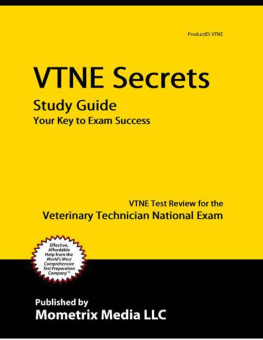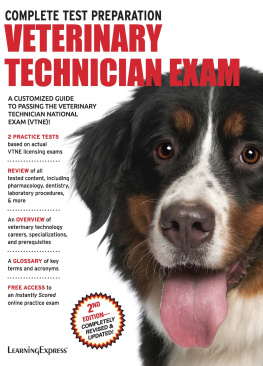Dear Future Exam Success Story: Congratulations on your purchase of our study guide. Our goal in writing our study guide was to cover the content on the test, as well as provide insight into typical test taking mistakes and how to overcome them. Standardized tests are a key component of being successful, which only increases the importance of doing well in the high-pressure high-stakes environment of test day. How well you do on this test will have a significant impact on your future- and we have the research and practical advice to help you execute on test day. The product youre reading now is designed to exploit weaknesses in the test itself, and help you avoid the most common errors test takers frequently make. How to use this study guide We dont want to waste your time. Our study guide is fast-paced and fluff-free. We suggest going through it a number of times, as repetition is an important part of learning new information and concepts. First, read through the study guide completely to get a feel for the content and organization. Read the general success strategies first, and then proceed to the content sections. Each tip has been carefully selected for its effectiveness. Second, read through the study guide again, and take notes in the margins and highlight those sections where you may have a particular weakness. Finally, bring the manual with you on test day and study it before the exam begins. Your success is our success We would be delighted to hear about your success. Send us an email and tell us your story. Thanks for your business and we wish you continued success- Sincerely, Mometrix Test Preparation Team
Secret Key #1 - Time is Your Greatest Enemy
Pace Yourself Wear a watch. At the beginning of the test, check the time (or start a chronometer on your watch to count the minutes), and check the time after every few questions to make sure you are on schedule. If you are forced to speed up, do it efficiently. Usually one or more answer choices can be eliminated without too much difficulty. Above all, dont panic. Dont speed up and just begin guessing at random choices. By pacing yourself, and continually monitoring your progress against your watch, you will always know exactly how far ahead or behind you are with your available time. If you find that you are one minute behind on the test, dont skip one question without spending any time on it, just to catch back up. Take 15 fewer seconds on the next four questions, and after four questions you'll have caught back up. Once you catch back up, you can continue working each problem at your normal pace. Furthermore, dont dwell on the problems that you were rushed on. If a problem was taking up too much time and you made a hurried guess, it must be difficult. The difficult questions are the ones you are most likely to miss anyway, so it isnt a big loss. It is better to end with more time than you need than to run out of time. Lastly, sometimes it is beneficial to slow down if you are constantly getting ahead of time. You are always more likely to catch a careless mistake by working more slowly than quickly, and among very high-scoring test takers (those who are likely to have lots of time left over), careless errors affect the score more than mastery of material.
Secret Key #2 - Guessing is not Guesswork You probably know that guessing is a good idea - unlike other standardized tests, there is no penalty for getting a wrong answer. Even if you have no idea about a question, you still have a 20-25% chance of getting it right. Most test takers do not understand the impact that proper guessing can have on their score. Unless you score extremely high, guessing will significantly contribute to your final score. Monkeys Take the Test What most test takers dont realize is that to insure that 20-25% chance, you have to guess randomly. If you put 20 monkeys in a room to take this test, assuming they answered once per question and behaved themselves, on average they would get 20-25% of the questions correct. Put 20 test takers in the room, and the average will be much lower among guessed questions. Why? 1. The test writers intentionally writes deceptive answer choices that look right. A test taker has no idea about a question, so picks the best looking answer, which is often wrong. The monkey has no idea what looks good and what doesnt, so will consistently be lucky about 20-25% of the time. 2. Test takers will eliminate answer choices from the guessing pool based on a hunch or intuition. Simple but correct answers often get excluded, leaving a 0% chance of being correct. The monkey has no clue, and often gets lucky with the best choice. This is why the process of elimination endorsed by most test courses is flawed and detrimental to your performance- test takers dont guess, they make an ignorant stab in the dark that is usually worse than random. $5 Challenge Let me introduce one of the most valuable ideas of this course- the $5 challenge: You only mark your best guess if you are willing to bet $5 on it. You only eliminate choices from guessing if you are willing to bet $5 on it. Why $5? Five dollars is an amount of money that is small yet not insignificant, and can really add up fast (20 questions could cost you $100). Likewise, each answer choice on one question of the test will have a small impact on your overall score, but it can really add up to a lot of points in the end. The process of elimination IS valuable. The following shows your chance of guessing it right:
However, if you accidentally eliminate the right answer or go on a hunch for an incorrect answer, your chances drop dramatically: to 0%. By guessing among all the answer choices, you are GUARANTEED to have a shot at the right answer. Thats why the $5 test is so valuable- if you give up the advantage and safety of a pure guess, it had better be worth the risk. What we still havent covered is how to be sure that whatever guess you make is truly random. Heres the easiest way: Always pick the first answer choice among those remaining. Such a technique means that you have decided, before you see a single test question , exactly how you are going to guess- and since the order of choices tells you nothing about which one is correct, this guessing technique is perfectly random. This section is not meant to scare you away from making educated guesses or eliminating choices- you just need to define when a choice is worth eliminating. The $5 test, along with a pre-defined random guessing strategy, is the best way to make sure you reap all of the benefits of guessing.
Secret Key #3 - Practice Smarter, Not Harder Many test takers delay the test preparation process because they dread the awful amounts of practice time they think necessary to succeed on the test. We have refined an effective method that will take you only a fraction of the time. There are a number of obstacles in your way to succeed. Among these are answering questions, finishing in time, and mastering test-taking strategies. All must be executed on the day of the test at peak performance, or your score will suffer. The test is a mental marathon that has a large impact on your future. Just like a marathon runner, it is important to work your way up to the full challenge. So first you just worry about questions, and then time, and finally strategy: Success Strategy 1. Find a good source for practice tests. If you are willing to make a larger time investment, consider using more than one study guide- often the different approaches of multiple authors will help you get difficult concepts. Take a practice test with no time constraints, with all study helps open book. Take your time with questions and focus on applying strategies. 4. Take a practice test with time constraints, with all guides "open book." 5. Take a final practice test with no open material and time limits If you have time to take more practice tests, just repeat step 5. By gradually exposing yourself to the full rigors of the test environment, you will condition your mind to the stress of test day and maximize your success.




